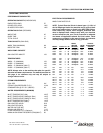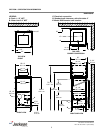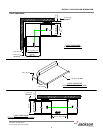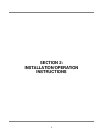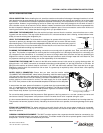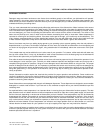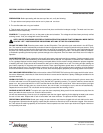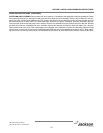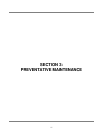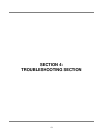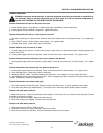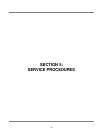
9
SECTION 2: INSTALLATION/OPERATION INSTRUCTIONS
OPERATION INSTRUCTIONS
PREPARATION: Before proceeding with the start-up of the unit, verify the following:
1. The pan strainers and pump suction strainer are in place and are clean.
2. The overflow tube and o-ring are installed.
3. That the wash and rinse arm assemblies are secured into place and that their endcaps are tight. The wash and rinse arm
assemblies should rotate freely.
POWER UP: To energize the unit, turn on the power at the service breaker. The voltage should have been previously verified
as being correct. If not, the voltage will have to be verified.
NOTE: UNLESS OTHERWISE SPECIFIED IN THESE INSTRUCTION, ENSURE THAT THE MANUAL MODE SWITCH
IS IN THE “OFF” POSITION BEFORE PROCEEDING WITH ANY OF THE FOLLOWING STEPS.
FILLING THE WASH TUB: Place the power switch into the ON position. Then place the cycle mode switch in the AUTO posi-
tion. The machine should fill automatically and shut off when the appropriate level is reached (just below the pan strainer). Verify
that the drain stopper is preventing the wash tub water from pouring out excessively. There may be some slight leakage from
the drain hole. Verify that there are no other leaks on the unit before proceeding any further. The wash tub must be complete-
ly filled before operating the wash pump to prevent damage to the component. Once the wash tub is filled, the unit is ready for
operation.
WARE PREPARATION: Proper preparation of ware will help ensure good results and less re-washes. If not done properly, ware
may not come out clean and the efficiency of the dishmachine will be reduced. It is important to remember that a dishmachine
is not a garbage disposal and that simply throwing unscraped dishes into the machine simply defeats the purpose altogether
of washing the ware. Scraps should be removed from ware prior to being loaded into a rack. Pre-rinsing and pre-soaking are
good ideas, especially for silverware and casserole dishes. Place cups and glasses upside down in racks so that they do not
hold water during the cycle. The dishmachine is meant not only to clean, but to sanitize as well, to destroy all of the bacteria
that could be harmful to human beings. In order to do this, ware must be properly prepared prior to being placed in the machine.
DAILY MACHINE PREPARATION: Refer to the section entitled “PREPARATION” at the top of this page and follow the instruc-
tions there. Afterwards, check that all of the chemical levels are correct and/or that there is plenty of detergent available for the
expected workload.
WARM-UP CYCLES: For a typical daily start-up, it is probably a good idea to run the machine through 3 cycles to ensure that
all of the cold water is out of the system and to verify that the unit is operating correctly. To cycle the machine, ensure that the
power is on, the cycle mode switch is in AUTO and that the tub has filled to the correct level. Lift the doors and the cycle light
will illuminate. When the light goes out, close the doors, the unit will start, run through the cycle, and shut off automatically.
Repeat this two more times. The unit should now be ready to proceed with the washing of ware.
WASHING A RACK OF WARE: To wash a rack, open the doors completely (being careful for hot water that may drip from the
doors) and slide the rack into the unit. Close the doors and the
unit will start automatically. Once the cycle is completed, open the door (again watching for the dripping hot water) and remove
the rack of clean ware. Replace with a rack of soiled ware and close the doors. The process will then repeat itself.
OPERATIONAL INSPECTION: Based upon usage, the pan strainers may become clogged with soil and debris as the work-
day progresses. Operators should regularly inspect the pan strainers to ensure they have not become clogged. If the strainers
do, it will reduce the washing capability of the machine. Instruct operators to clean out the pan strainers at regular intervals or
as required by work load.
200 Series Technical Manual
7610-100-45-00 Rev. E (02/10/2006)




